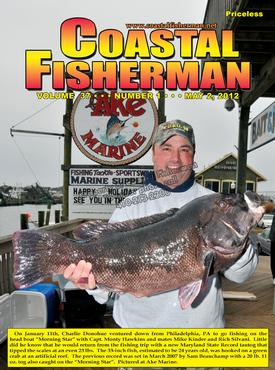


Article by
 Q: What are the 4 keys to a successful flounder fishing trip?
Q: What are the 4 keys to a successful flounder fishing trip?
Jon Pulsifer
Allegheny Twp., PA
A: As with any type of fishing it can look like everything is perfect... all the stars are in alignment and it is going to be a great day for flounder fishing, but the day ends up being a bust. It happens to everyone. However, there are 4 key items that I look for when planning a flounder trip. They are water clarity, water temperature, tide and bait selection.
Since flounder are sight feeders, water clarity is probably the most important factor for a successful flounder trip. In the bay behind Ocean City, a greenish water color is what you are looking for. You don’t want to see water that is all muddied up, looking brownish. The tide plays an important role in water clarity. Sometimes the water is cleaner during the incoming tide, while other times the outgoing tide cleaner. If the ocean is churned up because of a recent storm, then the incoming tide will bring that dirty water in the bay. A lot of times, you can actually see the line of clean or dirty water right in the inlet.
The water behind Assateague, especially down closer to the Assateague Bridge, can get very dirty with a lot of slur and grass in the water. You definitely want to stay away from this type of condition and maybe move up into the Thorofare where the water may be cleaner. The slur will drive you crazy and the dirty water will shut down the flounder bite.
Water temperature is extremely important in the spring. I like to see the water temperature get over 60-degrees. In the summer, when the bay water can get too hot, I look for deeper holes to drift across where the water on the bottom is cooler.
Being a charter boat, I need to fish whenever the trip is scheduled and sometimes this can conflict with a ideal tide, another important factor in flounder fishing.
In the spring, I like the outgoing tide because the shallow water has a chance to warm-up in the sun. During the summer, the incoming tide can be better because it brings the cooler ocean water into the bay.
As far as timing is concerned, you want to stay away from both slack tide and when currents are really ripping. In places like the East Channel, where the current can really move during parts of the tide, I will switch to a different location that has a slower current. When the tide is slack I will move to a location where the water is moving. Most people agree that the two hours before the high and low tides seem to produce the best catches.
Bait selection is extremely important. In the past, everyone seemed to fish with minnows and squid. However, in recent years the introduction of Gulp! artificial baits caused a lot of anglers to switch over. I prefer the Gulp! Alive Swimming Mullet in white and chartreuse during the summer and pink in the spring. They really work!
During the summer, I love to use live spot, peanut bunker and mullet. You can really catch some big flounder using live bait!
Do you have a question for a local pro? Email your question to [email protected]. Don’t forget to include your name, town and phone number.